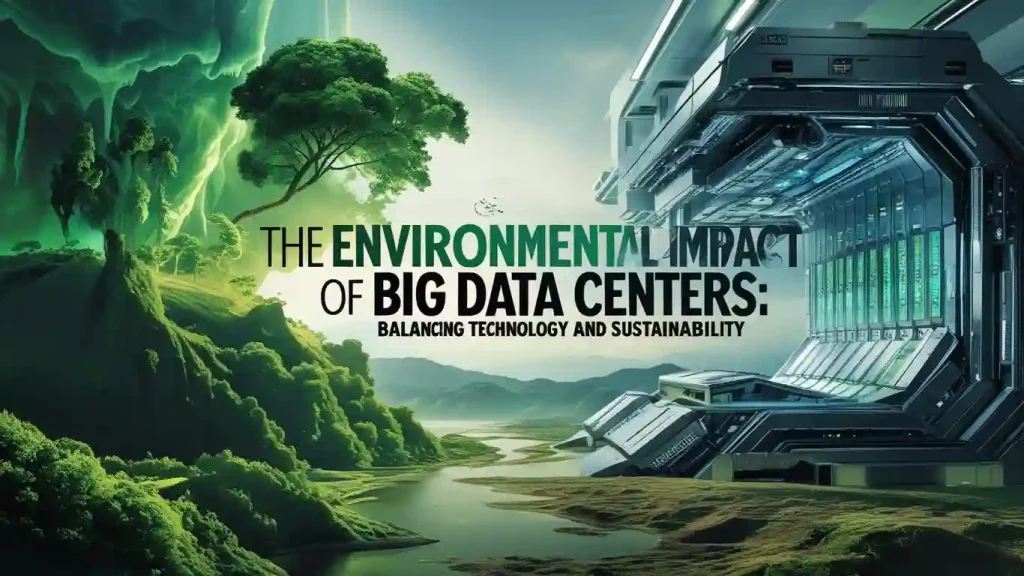
Powering cloud computing, artificial intelligence, social media, and e-commerce, large-scale data centers are essential to the digital era. These sprawling facilities house thousands of data servers that process and store massive amounts of information. However, their environmental footprint is significant, raising concerns about energy consumption, carbon emissions, e-waste, and resource depletion. As the demand for data storage and processing grows, so does the urgency to address the environmental impact of big data centers. This article explores the multifaceted effects of data centers on the environment, their challenges, and the innovative solutions driving sustainability.
The Growing Footprint of Big Data Centers
Big data centers are energy-intensive facilities that operate 24/7 to ensure seamless access to data. According to the International Energy Agency (IEA), data centers account for approximately 1-1.5% of global electricity consumption, a figure projected to rise as digitalization accelerates. The environmental impact of these facilities stems from their energy demands, cooling requirements, water usage, and electronic waste generation.
Also Read: Cloudbursts 2025: Nature’s Fury Unleashed
1. Energy Consumption and Carbon Footprint
Data centers are power-hungry. A single large-scale data center can consume as much electricity as a small city. Just one hyperscale data center can use as much as 20 to 50 megawatts of power — the equivalent energy demand of tens of thousands of residential homes. This energy demand contributes significantly to greenhouse gas emissions, especially when powered by fossil fuels.
- Carbon Emissions: Data centers contribute to global carbon dioxide (CO2) emissions, with estimates suggesting they account for about 0.3% of global CO2 emissions. In regions where coal or natural gas dominates the energy grid, the carbon footprint of data centers is particularly high.
- Inefficient Energy Use: Power Usage Effectiveness (PUE) quantifies how effectively a data center utilizes its energy resources. A PUE of 1.0 indicates perfect efficiency, but many older facilities have PUEs ranging from 1.5 to 2.0, meaning up to half the energy is used for non-computing tasks like cooling and lighting.
2. Cooling Systems and Water Usage
Data servers generate immense heat, requiring sophisticated cooling systems to prevent overheating. These systems, while essential, have significant environmental implications:
- Energy for Cooling: Cooling accounts for 30-40% of a data center’s energy consumption. Traditional air-conditioning systems are energy-intensive, further increasing the carbon footprint.
- Water Consumption: Many data centers use water-based cooling systems, such as evaporative cooling towers. A single large data center can consume millions of gallons of water annually, straining local water resources, especially in water-scarce regions. Water consumption by Google’s data centers reached 15.7 billion liters in 2021, intensifying concerns about resource use in dry and drought-prone areas.
3. E-Waste and Resource Depletion
The rapid pace of technological advancement leads to frequent hardware upgrades, resulting in significant electronic waste (e-waste). Data centers rely on servers, storage devices, and networking equipment, all of which have finite lifespans.
- E-Waste Generation: Globally, e-waste is a growing problem, with data centers contributing to the 50 million metric tons of e-waste produced annually. Improper disposal of servers and components can release toxic materials like lead, mercury, and cadmium into the environment.
- Resource Extraction: Manufacturing servers requires rare earth metals and other finite resources, leading to environmental degradation through mining and processing activities.
Also Read: How Climate Change Effects Farming
The Broader Environmental Implications
The environmental impact of big data centers extends beyond their immediate operations. Their reliance on global supply chains, energy grids, and infrastructure amplifies their ecological footprint.
1. Strain on Energy Grids
The exponential growth of data centers is putting pressure on energy grids worldwide. In some regions, data centers compete with residential and industrial users for electricity, driving up costs and necessitating new power plants, often powered by fossil fuels.
2. Land Use and Ecosystem Disruption
Building large data centers requires significant land, often leading to deforestation or habitat destruction. For example, constructing a hyperscale data center may require clearing hundreds of acres, impacting local biodiversity.
3. Social and Ethical Concerns
The environmental impact of data centers is unevenly spread across different regions. Developing countries, where many data centers are built due to lower costs, often bear the brunt of pollution and resource depletion. Additionally, communities near data centers may face water shortages or increased energy costs, raising ethical questions about equitable resource distribution.
Toward Sustainable Data Centers: Solutions and Innovations
As awareness of the environmental impact of big data centers grows, the tech industry is investing in sustainable practices to mitigate their footprint. Below are some key strategies and innovations driving data center sustainability:
1. Renewable Energy Adoption
Many tech giants, including Google, Microsoft, and Amazon, have committed to powering their data centers with renewable energy sources like solar, wind, and hydropower.
- Google’s Commitment: In 2017, Google met its goal of powering all global operations with renewable energy and has since maintained a focus on carbon-neutral data centers.
- Power Purchase Agreements (PPAs): Companies sign PPAs to secure renewable energy, ensuring a stable supply while reducing reliance on fossil fuels.
- On-Site Renewables: Some data centers integrate solar panels or wind turbines on-site, reducing their dependence on external grids.
2. Energy-Efficient Technologies
Data center efficiency is improving thanks to progress in both hardware and software technologies:
- AI-Optimized Servers: Artificial intelligence is used to optimize server workloads, reducing energy consumption. For example, Google’s DeepMind AI reduced cooling energy use by 40% in its data centers.
- Low-Power Hardware: Newer server designs, such as those using ARM-based processors, consume less power than traditional systems.
- Virtualization: By running multiple virtual servers on a single physical server, virtualization reduces the number of machines needed, lowering energy use.
3. Innovative Cooling Solutions
Cooling remains a significant challenge, but innovative solutions are emerging:
- Liquid Cooling: Immersion cooling, where servers are submerged in non-conductive liquids, is more efficient than air cooling and reduces water usage.
- Free Cooling: Data centers in colder climates, like those in Scandinavia, use ambient air for cooling, significantly reducing energy costs.
- Geothermal Cooling: Some facilities leverage underground temperatures for natural cooling, minimizing energy and water use.
4. Circular Economy and E-Waste Management
To address e-waste, companies are adopting circular economy principles:
- Server Refurbishment: Extending the lifespan of servers through refurbishment reduces the need for new hardware.
- Recycling Programs: Companies like Dell and HPE have robust recycling programs to recover materials from decommissioned servers.
- Modular Designs: Modular servers allow components to be replaced or upgraded without discarding entire systems, reducing waste.
5. Water Conservation Strategies
To reduce water consumption, data centers are adopting water-efficient technologies:
- Closed-Loop Cooling: These systems recycle water within the facility, minimizing freshwater use.
- Air-Cooled Systems: In water-scarce regions, air-based cooling systems are replacing water-intensive methods.
- Rainwater Harvesting: Some data centers collect rainwater for cooling, reducing reliance on municipal water supplies.
Challenges in Achieving Data Center Sustainability
Despite these advancements, several challenges hinder the transition to green data centers:
- High Initial Costs: Implementing renewable energy systems or advanced cooling technologies requires significant upfront investment, which may deter smaller operators.
- Geographic Limitations: Not all regions have access to renewable energy or climates suitable for free cooling.
- Regulatory Gaps: Inconsistent environmental regulations across countries make it difficult to enforce sustainable practices globally.
- Data Demand Growth: The rapid increase in data consumption, driven by AI, IoT, and 5G, outpaces efficiency gains, making it challenging to reduce overall environmental impact.
The Role of Stakeholders in Promoting Sustainability
Achieving sustainable data centers requires collaboration among multiple stakeholders:
- Tech Companies: Industry leaders must continue investing in renewable energy, efficient technologies, and transparent reporting of their environmental impact.
- Governments: Policymakers can incentivize green practices through tax breaks, subsidies for renewable energy, and stricter e-waste regulations.
- Consumers: By choosing eco-conscious providers, consumers can drive demand for sustainable data services.
- Innovators: Startups and researchers play a critical role in developing cutting-edge technologies for energy efficiency and waste reduction.
Case Studies: Leaders in Data Center Sustainability
Microsoft’s Underwater Data Center: Microsoft’s Project Natick explores underwater data centers that use ocean water for cooling, reducing energy and water consumption.
- Facebook’s Luleå Data Center: Located in Sweden, this facility uses hydroelectric power and free cooling, achieving a PUE of 1.04, one of the lowest in the industry.
- Apple’s Renewable Energy Commitment: Apple’s data centers run on 100% renewable energy, with investments in solar farms and energy storage systems.
The Future of Big Data Centers
The future of big data centers lies in balancing technological innovation with environmental stewardship. Emerging trends include:
- Edge Computing: Decentralized edge data centers reduce latency and energy use by processing data closer to users.
- Carbon Capture: Some companies are exploring carbon capture technologies to offset emissions from data centers.
- Zero-Waste Goals: Leading firms aim for zero-waste data centers by recycling all materials and minimizing resource use.
Conclusion
Big data centers are indispensable to the modern world, but their environmental impact cannot be ignored. From high energy consumption and carbon emissions to water usage and e-waste, these facilities pose significant challenges to sustainability. However, through renewable energy, innovative cooling, and responsible e-waste management, the industry is making strides toward data center sustainability. By addressing challenges and embracing collaboration, stakeholders can ensure that big data centers power the digital future without compromising the planet.
FAQs
What are the environmental impacts of data centres?
Data centres consume massive energy, emit greenhouse gases, generate e-waste, and strain water resources—contributing to climate change and local pollution.
How are data centers becoming more sustainable?
Data centers are going green by using renewable energy, efficient cooling systems, and AI-powered energy optimization.
Do data centers produce waste?
Yes, data centers produce e-waste from outdated hardware and contribute to carbon emissions through high energy use.
Who cleans data centers?
Trained professionals or specialized cleaning teams clean data centers using anti-static tools to protect sensitive equipment and maintain optimal performance.
How does data impact our lives?
Data shapes our lives by powering smart decisions, personalized services, and innovations in health, transport, and communication.

